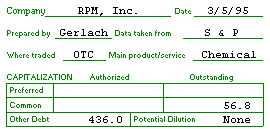|
General Information & Capitalization
General Information
At the top of the SSG form is an area to record some general information about your stock study. This information is for your own reference, and most of the fields are fairly self-explanatory.

- Company
- The name of the company.
- Date
- The date the study was completed.
- Prepared by
- Your name or initials.
- Data taken from
- The source of the data, commonly Value Line, Standard & Poor's, or a company's annual report.
- Where traded
- The exchange or service where the stock is traded, e.g., NYSE, AMEX (ASE), or NASDAQ (OTC).
- Major product/service
- The company's industry group.
Capitalization
In this area, information is recorded about a company's capital structure. Capitalization is simply the way a business is financed, including common and preferred stock, long-term debt and retained earnings. The figures in this section are not used for any calculations, but rather serve as "flags" to potential problems.
- Preferred and Common Stock
- Enter the number of shares outstanding and the number of shares that the company is authorized to issue. A company's articles of incorporation establish the number of shares the company is authorized to issue, which may often be much higher than the number of shares actually outstanding. The company may raise additional capital by issuing additional shares that have been authorized, but shareholders must approve any new issues. These figures can be found in the company's annual report; Value Line and Standard & Poor's report only the number of shares outstanding.
- Other Debt
- Record here the Total Debt of the company you are analyzing. If debt seems sizable (with reference to the company's own history or in comparison to others in the same industry), perhaps a further look at the company's financial structure is warranted. Standard & Poor's does not report Total Debt, but only Long-Term Debt.
- Potential Dilution
- The most common forms of dilution are unexercised options (an option to buy a number of shares at a pre-set price some point in the future, usually issued to key management) and convertible securities (usually debentures and preferred stock that can be exchanged at a later date for common stock). Enter the number of shares by which the number of outstanding shares could possibly increase if these authorized options were exercised and convertible securities redeemed. Dilution is not favorable because it "waters down" the value of the shares held by existing shareholders. Both Value Line and Standard & Poor's include potential dilution in the Capitalization section; no entry means no dilution is likely. As of 1998, changes in accounting laws require that companies report "fully-diluted EPS," taking into account the effects of dilution on the profits. Therefore, it's not usually necessary to include dilution here, since it's already been taken in account in the report of earnings.
Next
|
|
